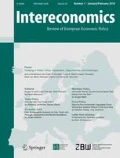Abstract
In November 1981 Hungary and, one week later, Poland applied for membership of the International Monetary Fund (IMF) and the International Bank for Reconstruction and Development (World Bank). These applications have highlighted a subject which had been neglected for quite some time. This analysis deals with the problems and consequences which arise from the membership of countries of the Council for Mutual Economic Assistance (Comecon)—the economies of which largely conform to principles of central economic planning—in IMF, an institution organized according to market principles.
Similar content being viewed by others
References
See Exchange, Price Reform are Key Elements in Romania’s New Stabilization Program, in: IMF Survey, September 7, 1981, p. 262 ff.
Cf. A. Köves: Turning Inward or Turning Outward: Reflections on the Foreign Economic Strategy of CMEA Countries, in: Acta Oeconomica, Vol. 26 (1–2), 1981, p. 51 ff.
Cf. K. Schröder: Aspekte zukünftiger Finanzbeziehungen zwischen Ost und West (Aspects of future financial relations between East and West), in: Osteuropa Wirtschaft, 27th year, No. 1/1982, p. 35 ff.
Author information
Authors and Affiliations
Rights and permissions
About this article
Cite this article
Schröder, K. The IMF and the countries of the Council for Mutual Economic Assistance. Intereconomics 17, 87–90 (1982). https://doi.org/10.1007/BF02924831
Issue Date:
DOI: https://doi.org/10.1007/BF02924831




